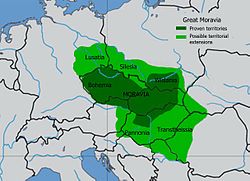Magna Moravia
| Moravia | ||||||||||||||||||||||||||
|
Regnum Marauorum/Marahensium (la) Terra Marauorum/Marahensium (la) |
||||||||||||||||||||||||||
|
||||||||||||||||||||||||||
|
Great Moravia in the late ninth century
|
||||||||||||||||||||||||||
| Capital | Mikulčice (?) | |||||||||||||||||||||||||
| Languages | Old Slavic | |||||||||||||||||||||||||
| Religion | ||||||||||||||||||||||||||
| Government | Principality | |||||||||||||||||||||||||
| kъnendzь or vladyka (King, Ruler), in the international context also translated as Prince or Duke | ||||||||||||||||||||||||||
| • | c. 820/830 | Mojmír I first | ||||||||||||||||||||||||
| • | 846 | Rastislav | ||||||||||||||||||||||||
| • | 870 | Svätopluk I | ||||||||||||||||||||||||
| • | 894 | Mojmír II last | ||||||||||||||||||||||||
| History | ||||||||||||||||||||||||||
| • | Established | 833 | ||||||||||||||||||||||||
| • | Decline and fall | c. 906/907 | ||||||||||||||||||||||||
|
||||||||||||||||||||||||||
Great Moravia (Latin: regnum Marahensium, Greek: Μεγάλη Μοραβία – megale Moravia, Czech: Velká Morava, Slovak: Veľká Morava, Polish: Wielka Morawia), the Great Moravian Empire, (historiographical terms – original formal name is unknown) or simply Moravia, was the first major state that was predominantly Slavonic to emerge in the area of Central Europe. Its core territories were located on the Morava river which gave its name to the kingdom. "Morava" in both Czech and Slovak refers to both the river and the land of Moravia - the medieval Margraviate of Moravia, which is now the eastern part of the Czech Republic. The river Morava flows south through the whole of Moravia, later forming the present-day border between the Czech Republic and Slovakia before finally becoming the border between Slovakia and Austria (where it is called the March in German). The kingdom saw the rise of the first ever Slavic literary culture in the Old Church Slavonic language. After the fall of Great Moravia, its core territory was gradually divided between the newly ascending Czech Kingdom (Bohemia) and Hungarian Kingdom: the frontier was originally settled on the Morava river (the Czech Kingdom to its west, and Hungary - present-day Slovakia - to its east). However, from the 12th century, the Czech kings managed to gain more and more of the region on the eastern bank - eventually gaining the whole stretch of the eastern territory from Uherské Hradiště down to Strážnice, and this region retained its non-Czech identity in its designation "Slovácko" as an alternative dialectal for "Slovakia". After this, the Czech-Hungarian border shifted east to the White Carpathians. The core region of Great Moravia along the Morava river, thus divided between the present-day Moravia and Slovakia, has retained a unique culture in the rich folklore tradition both on the western bank of the Morava (including the southern Záluží region) and the eastern bank - the Slovácko (in Moravia) and Záhorie (in Slovakia). Záhorie is also home to the only surviving building dating from Great-Moravian time - St Margaret of Antioch church at Kopčany (just across the Morava from Mikulčice).
...
Wikipedia

